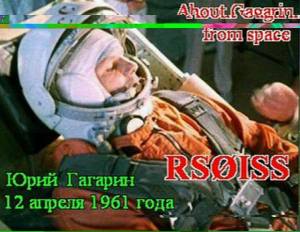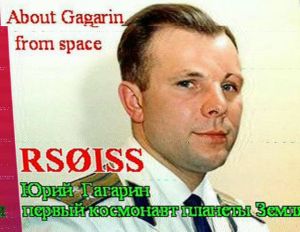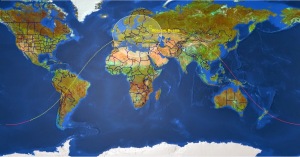On Saturday, September 6, at 1000 GMT Paulo PV8DX emailed the news that the International Space Station (ISS) Slow Scan Television (SSTV) on 145.800 MHz FM had been active again.
At the end of the passage (ISS) in northern Brazil where I live. I heard the sound of early SSTV. So I went to the WEBSDR in your area [the SUWS WebSDR near London, UK] and I got two images.
The ISS has been transmitting photographs devoted to the life and work of the first cosmonaut Yuri Gagarin. They were sent in the PD180 SSTV mode with additional voice commentary.
On August 27, 2014 a test of the ISS Slow Scan Television (SSTV) experiment MAI-75 using the Kenwood TM-D710 transceiver and a new cable took place. Although a carrier was successfully transmitted on 145.800 MHz no SSTV audio tones were heard. It appears that the earlier problem has now been rectified. https://amsat-uk.org/2014/08/23/iss-sstv-august-27/
The Kenwood TM-D710 was delivered to the ISS in the summer of 2012. The original TM-D700 in the Russian ISS Service Module had been experiencing problems with the PA after giving many years service in space, see ARISS minutes for March 2013. It is thought the Kenwood TM-D710 is set to run at just 5 watts output because convection cooling doesn’t work in zero gravity. http://www.ariss.org/meeting-minutes/archives/03-2013
David Barber G8OQW received some good images in Chelmsford, Essex which can be seen on the AMSAT-UK Facebook page.
Listen to the ISS and amateur radio satellites online using the SUWS VHF/UHF/Microwave WebSDR https://amsat-uk.org/2014/08/15/suws-websdr-moves-to-new-site/
ISS Fan Club provides status and tracking information http://issfanclub.com/
How to hear the ISS https://amsat-uk.org/beginners/how-to-hear-the-iss/
Paul Turner G4IJE, co-developer of the SSTV PD modes, says regarding the PD180 mode: “Don’t forget to either enable “Always show RX viewer” or use the “Picture viewer” (magnifying glass icon) to show the picture at its real resolution of 640 x 496. If you just view as normal you will only see 320 x 248 resolution, which kind of defeats the object of using a high resolution mode.”
Tony Falla VK3KKP commented “I received a good picture from ISS on my iPad mid-Saturday evening [AEDT] on 145.800 MHz just using the microphone next to the rig.”
The APRS digipeater in the European Space Agency ISS Columbus module continued to be in operation on 145.825 MHz during the SSTV transmissions.
Watch a video of ISS SSTV reception by Dmitry Pashkov R4UAB
All you need to do to receive SSTV pictures direct from the space station is to connect the audio output of a scanner or amateur radio transceiver via a simple interface to the soundcard on a Windows PC or an Apple iOS device, and tune in to 145.800 MHz FM. You can even receive pictures by holding an iPhone next to the radio’s loudspeaker.
The ISS puts out a strong signal on 145.800 MHz FM and a 2m handheld with a 1/4 wave antenna will be enough to receive it. The FM transmission uses the 5 kHz deviation which is standard in much of the world.
Many FM rigs in the UK can be switched been wide and narrow deviation FM filters. For best results you should select the wider deviation filters. Handhelds all seem to have a single wide filter fitted as standard.
On Windows PC’s the free application MMSSTV can be used to decode the signal, on Apple iOS devices you can use the SSTV app. The ISS Fan Club website will show you when the space station is in range.
For more on Slow Scan Television SSTV, see this article SSTV – The Basics
http://www.essexham.co.uk/sstv-the-basics
How to be successful with the ISS Slow Scan Television (SSTV) imaging system
http://www.marexmg.org/fileshtml/howtoisssstv.html
Free MMSSTV Slow Scan TV software http://hamsoft.ca/pages/mmsstv.php
iOS SSTV App https://itunes.apple.com/gb/app/sstv/id387910013
IZ8BLY Vox Recoder, enables you to record the signals from the ISS on 145.800 MHz while you’re away at work http://antoninoporcino.xoom.it/VoxRecorder/
ARISS Slow Scan TV (SSTV) Blog and Gallery http://ariss-sstv.blogspot.co.uk/
Information on the MAI-75 SSTV experiment
http://www.energia.ru/eng/iss/researches/education-26.html












You must be logged in to post a comment.